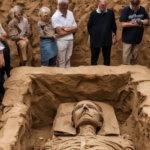Shocking Revelation: China Unearths Spectacular Two-Headed Dragon Fossil from 100,000 Years Ago, Capable of Breathing Fire
- mystery
- June 12, 2024

In a groundbreaking revelation that has sent ripples through the scientific and archaeological communities, Chinese researchers have uncovered an astonishing two-headed dragon fossil. This incredible discovery, which dates back 100,000 years, has shattered previous expectations and introduced a new chapter in our understanding of prehistoric life.
The fossil was found in the remote and rugged landscapes of the Qinling Mountains, a region already famous for its rich paleontological finds. A team of dedicated archaeologists and paleontologists, led by Dr. Li Wei, had been meticulously excavating a promising site when they stumbled upon something extraordinary buried deep within the earth.
At first, they unearthed a segment of a massive spine, followed by an enormous ribcage. As they continued to dig, the true nature of their find was revealed: a dragon-like creature with two distinct heads. The fossil, remarkably well-preserved, showcased intricate details of the beast’s anatomy, including elongated necks, fearsome teeth, and what appeared to be vestiges of wing-like structures.

News of the discovery quickly spread, drawing the attention of experts and enthusiasts worldwide. Dr. Li Wei held a press conference to share the preliminary findings. “This is an unprecedented discovery,” he said. “The sheer size and the unique anatomical features of this creature are unlike anything we have ever seen before. It challenges our understanding of prehistoric life and the evolutionary processes that could lead to such a remarkable being.”
The two-headed dragon, dubbed “Bifurcatus draconis,” has been subject to intensive study since its unearthing. Advanced imaging techniques and radiometric dating confirmed its age at around 100,000 years, placing it in a time period where such creatures were thought to be the stuff of legends rather than reality.

However, the most astonishing revelation came from an unexpected source. Analysis of the fossil’s cranial structure and comparison with other known species suggested a highly unusual capability: the potential to breathe fire. Researchers identified peculiar cavities in the skull that seemed to serve as chambers for mixing chemicals, a biological mechanism that could theoretically produce flames.
Dr. Margaret Chen, a renowned paleobiologist, explained this phenomenon. “The structure of Bifurcatus draconis is suggestive of a complex internal system that could generate a combustible reaction. While this is purely hypothetical at this stage, it is plausible that this creature possessed the ability to expel a fiery breath, much like the dragons of myth and legend.”

The discovery has reignited interest in dragon folklore and its possible basis in real creatures. Scholars are now examining ancient texts and myths with renewed vigor, seeking connections between the newly discovered dragon and the stories passed down through generations. Could the legends of dragons that permeate cultures around the world be rooted in distant memories of real encounters with such beasts?
As scientists continue to study the fossil, the implications of this find are vast. It not only opens up new avenues for understanding prehistoric ecosystems but also challenges the boundaries between myth and science. The tale of Bifurcatus draconis serves as a powerful reminder of the endless wonders that our world still holds, waiting to be discovered beneath the layers of time.
For now, the two-headed dragon fossil remains a symbol of human curiosity and the relentless quest for knowledge. Its discovery is a testament to the fact that even the most fantastical stories may contain a kernel of truth, hidden just beneath the surface, waiting for the right moment to be revealed.
4o










